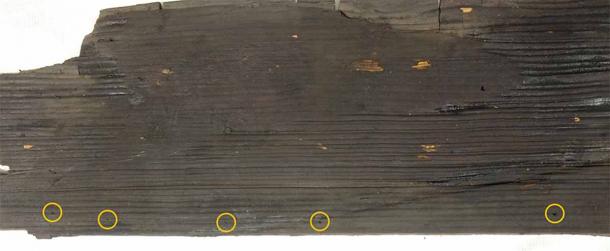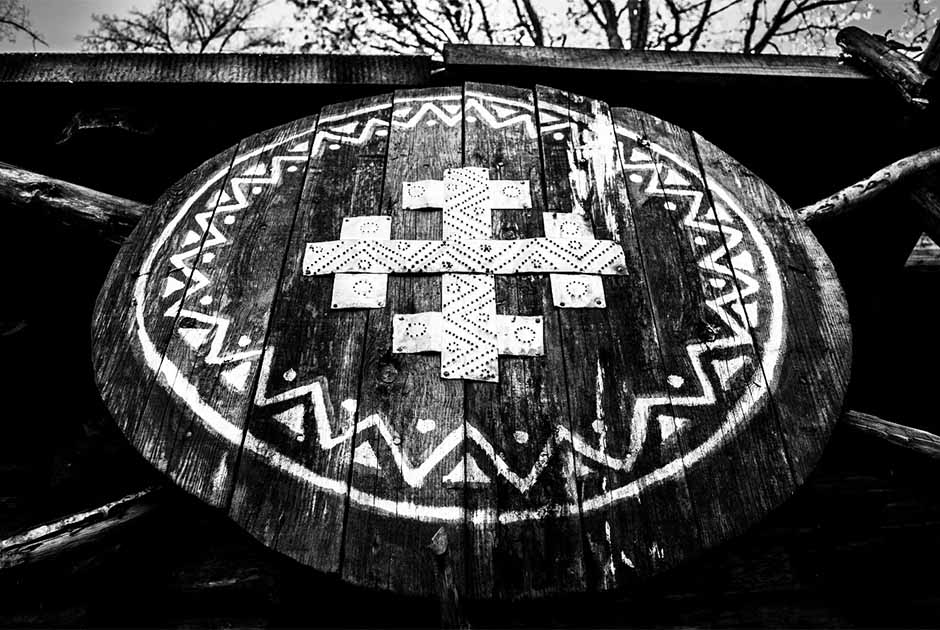Ceremonial Viking Shields Re-identified as Actual Battle-Worn Armor
A reexamination of 1,100-year-old wooden Viking shields excavated in Norway in 1880 have been used to assert that these round protective devices could very well have been used in hand-to-hand combat at some point. They may also have been used to add a layer of protective armor to Viking ships engaged in naval battles.
This conclusion came as a surprise. Past studies of the wooden Viking shields concluded that they were too thin and flimsy to have ever offered much protection in actual warfare, meaning they were most likely used strictly for ceremonial purposes.

Reconstruction of a Viking shield, front. (Museum of Cultural History / University of Oslo)
Stockholm University archaeologist and Viking combat expert Rolf Warming has just published the results of his new study of the Viking Age wooden armor, which was recovered in fragments from inside a buried Viking ship found under a large mound at Gokstad in eastern Norway.
- Dissolving Myths: Vikings Did NOT Hide Behind Shield Walls
- History of the Vikings: All You Need to Know
In the journal Arms & Armour, Warming explained that the Viking shields were manufactured in such a way as to be perfectly suitable for combat, despite previous conclusions to the contrary. While the shields may have been used as grave goods at the time the ship was sealed inside the mound around around the start of the 10th century/ c.901 AD, Warming argued that they may have been used in actual combat sometime before that.

A reconstructive drawing of the Gokstad long ship from Nicolaysen’s 1882 publication. Drawing by Harry Schøyen. (Rolf Fabricius Warming / CC BY-NC-ND 4.0)
Accepted Analysis of the Gokstad Viking Shields
Warming speculates that the 64 Viking shields discovered could have represented the number of men who served on the Gokstad ship when it was in service. Made from pine board, the Gokstad shields were comprised of wooden planks tapered at the end and rounded off on the outside, made to a size appropriate for a man engaged in hand-to-hand battle (the shields did have handles attached).
Despite the suggestive size and shape, the Viking shields were found without any animal skins attached. This protective layer would have been needed for them to function as hand-held defensive shields. Also, the wood in general was not especially thick.
After the discovery of the Viking shields in 1880, experts conducted an initial analysis and quickly concluded that they would have been ceremonial items only and would not have been used in combat. It was believed they’d been manufactured to be buried with the Gokstad ship when it reached the end of its lifespan.
However, as Rolf Warming pointed out, the existing scholarship on the wooden shield fragments showed that they had never actually undergone any detailed examination in the entire 140-plus years since they were originally excavated with the Gokstad ship.

Portion of one of the Viking shields excavated with the Gokstad ship in 1880. (Photo: © Museum of Cultural History, University of Oslo, Norway)
Reevaluating the Gokstad Viking Shields
Taking the initiative to address this omission, in 2019 Warming began his own study of the yellow and black painted shields. The objective was to investigate the possibility that they may have been used for more than just ceremonial purposes. He gained permission for his work from the Viking Ship Museum in Oslo, where the various remains and artifacts from the Viking ship have been stored and/or put on display.
“The unusually rich and well-preserved archaeological material from Gokstad has yielded valuable knowledge regarding both mundane and high-status material culture of the Viking Age (circa 750 to 1050 AD),” Warming wrote in his Arms & Armour article. “For scholars interested in the Viking Age warfare, the archaeological material holds special significance, being arguably one of the main sources of data for shield technologies of this period.”
The Viking longship and its impressive collection of grave goods, which included the material for the 64 shields, was found beneath a monumental burial mound near Vestfold in Norway. It was discovered in 1880 by antiquarian Nicolay Nicolaysen, who was responsible for the initial assumption that the wooden boards were too flimsy to have been used in actual combat without metal reinforcements.
After completing his recent examination, however, Warming was convinced that the evidence actually contradicted the assertion that the ancient Gokstad shields were not made for combat.

Longitudinal rows of perforations on the central board from Eske 5, indicated in yellow. (Rolf Fabricius Warming / Society for Combat Archaeology / CC BY-NC-ND 4.0)
The Evidence for Non-Ceremonial Use of the Viking Shields
Key to his findings were a series of perforations running around the rim of the wooden Viking shields. According to Warming, this strongly suggested the painted surface of the shields had once been covered with skin product, probably thin rawhide parchment which has been identified in older shields.
While the rawhide covering on the Gokstad shields is no longer present, the perforations were placed in the exact location where such a covering would need to be attached (and was attached on other ancient shields made to the same design specifications).
The perforations on the Viking shields were one piece of evidence Warming focused on. But overall he was impressed by how the shields seemed to conform to construction patterns seen in other ancient examples of battle armor. “In general terms, the craftsmanship is mostly in accordance with other shield finds that are judged to be of a practical nature and the Germanic flat round shield tradition as a whole,” he wrote, making the connection with other shields explicit.
- New Insights into the Viking Great Army: Cremation Site Unveils Surprising Details
- Viking Shield Technology Revealed in New Breakthrough Study
“This includes the majority of the constructional details, such as the shape and dimensions of the center holes as well as the boards, and, especially, their tapering,” explained Warming when discussing his research into the Gokstad shields. “In addition to the shaping of the very edge, some boards were tapered from further back, indicating a complex carpentry process that lends further credibility to notion of practical use.”
The conclusions of Warming’s study do not question that the Gokstad shields were used for ceremonial purposes. The fact that they were buried with the abandoned ship shows they were selected as grave goods, signifying their use as religious and ritualistic objects. What Warming did argue is that just because the Viking shields were used as ceremonial items does not mean they were never used in any other way.

Excavations of the Gokstad ship in 1880, where the Viking shields were uncovered. (Museum of Cultural History – University of Oslo / CC BY-SA 4.0)
Toward a More Nuanced Understanding of Viking Age Cultural Practices
When discussing his findings, Rolf Warming emphasized that his conclusions were tentative and did not necessarily prove that the ancient Viking shields were used in battle. Nevertheless, as a result of his reexamination, he called for a “more nuanced understanding of shield constructions of the Viking Age.”
“The preliminary findings of this paper offer new insights into the complexities of Viking Age shield technologies and their use in funerary rites, underlining the need for more comprehensive treatment of this material in the future,” he wrote in the summary of his Arms & Armour article.
For specialists in the field interested in learning more about this new study of ancient Viking Age armor, Warming will be giving an online lecture entitled "Ships and Shields, c. 900-1600 AD" for members of the Society for Combat Archaeology on April 6th 2023. This talk will focus on the Gokstad shields, but within the greater context of shipbuilding and warfare practices during the Viking Age and beyond.
Top image: Representative image of a round wooden shield similar to the Viking shields found at Gokstad. Source: Aleksandrs/Adobe Stock
By Nathan Falde




















Comments
I was looking for how a man would hold the shield while fighting. You’d expect a leather strap that his left forearm would go through, and hold tight.
So, are we supposed to believe the man held the knob in the back with his hand? Nope, try again.
It’s probably a barrel lid. Maybe there was no need for shield and fighting. And more a need for storing food, making beer and pickles, as they still do. They’re not much the warrior, if they ever were. Just in urban legends.
Nobody gets paid to tell the truth.